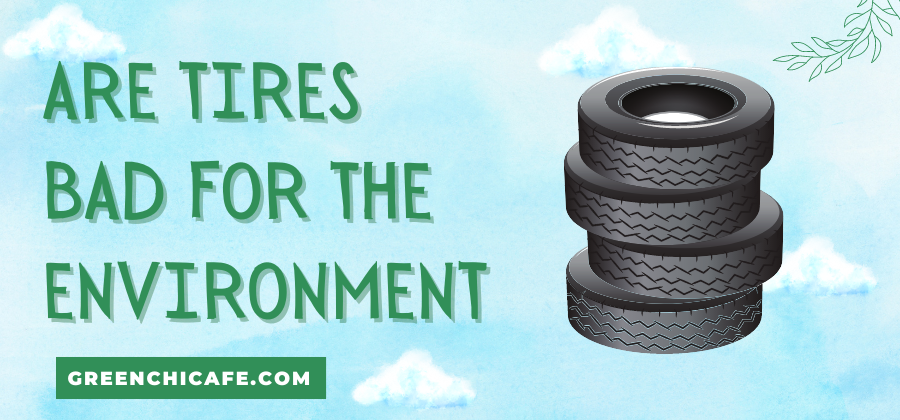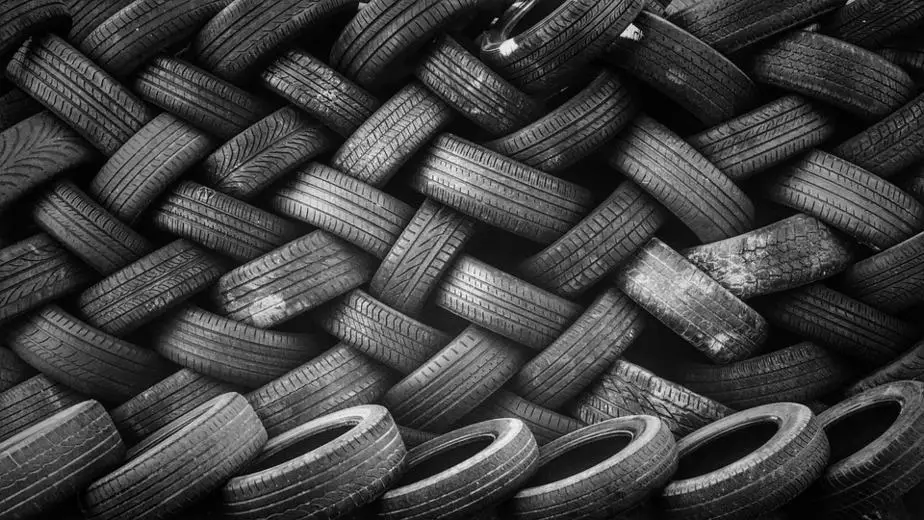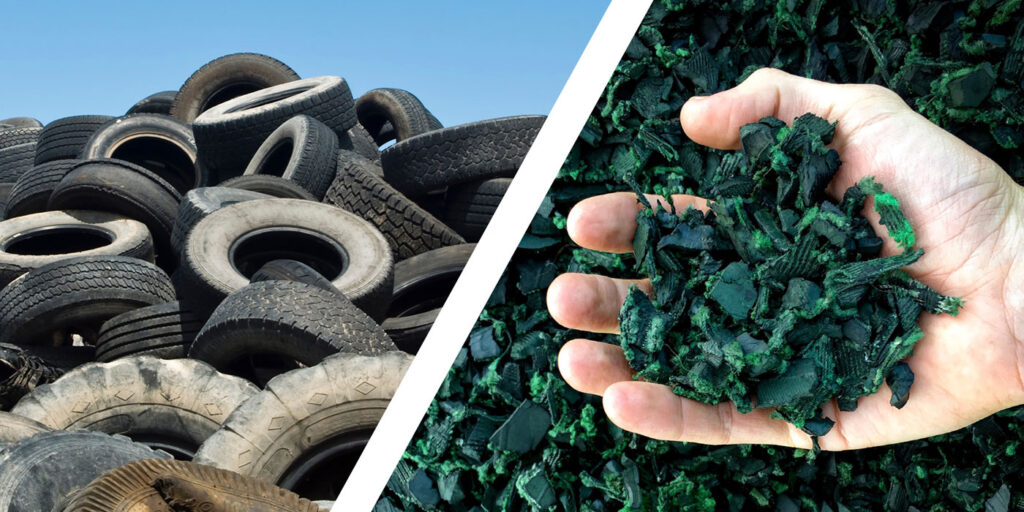Tires produce dangerous microplastic pollution and particulate matter that harm human health and the environment.
But do old tires decompose?
This article will uncover the truth about how tires affect the climate and wildlife.
Are Tires Bad for the Environment?
Yes, tires are undoubtedly bad for the environment.
From manufacturing to disposal, tires have monumental negative impacts on ecosystems, climate, and human health globally.
Key Points
- Tire particles pollute air, soil, and water with microplastics and dangerous chemicals.
- Producing and disposing of tires requires substantial resources and generates pollution.
- Tire materials do not readily decompose and persist in the environment.
What Are Tires Made Of? The Toxic Components
Tires contain many chemicals and compounds that make them durable and effective for vehicles.
But these same components also make tire waste incredibly problematic.
The materials that give tires their strength also make them challenging to break down.
Tires are constructed through a process called vulcanization that combines rubber, carbon black, metal, textile reinforcements, and various chemical additives.
Components like synthetic rubber, petroleum, steel cord, carbon, zinc oxide, sulfur, and silica help make tire treads sturdy and long-lasting.
Additives like oils and waxes help with performance.
The chemical 6PPD is extremely toxic to certain fish species.
Unfortunately, many substances leach out as microscopic tire rubber degrades.
How Do Tire Particles Harm Human Health?
As tires roll down roads, tiny particles and dust are left behind.
Researchers have discovered that dust contains dangerous fine particulate matter known as PM2.5.
When inhaled, these minuscule particles can migrate deep into the lungs.
PM2.5 is linked to respiratory issues, heart disease, and other health complications.
Studies have even tied increased overall mortality rates to PM2.5 exposure.
Living near highways elevates health risks.
Tire particles have also been found in air samples up to 90 meters from roadways.
Tire dust pollution isn’t just a roadside issue. It affects communities at large.
What Is the Impact of Tire Piles and Fires?
Whole tires are often dumped in unauthorized piles or burned as fuel.
But tires do not decompose, instead remaining intact for decades underground.
Left outside, tires fill with rainwater, creating ideal mosquito breeding conditions.
Tire fires generate substantial pollution and toxic fallout over a vast area.
The smoke is thick with carbon monoxide, sulfur oxides, volatile organic compounds, polycyclic aromatic hydrocarbons, and other toxins.
In 1983, a huge Virginia tire fire burned for 9 months, requiring 10,000 firefighters to extinguish it.
Tire fires can burn for months or years, devastating wildlife and local communities.
Why Are Tires an Underwater Threat?
Tire materials easily wash into oceans, lakes, and rivers, contributing to the global microplastic crisis.
Synthetic fibers and rubber erode into tiny fragments called microplastics.
The National Oceanic and Atmospheric Administration estimates that over 5.5 trillion particles of plastic pollute the ocean.
Tire particles make up a significant proportion of this plastic waste.
Fish and other species ingest these colorful fragments, absorbing dangerous chemicals that may enter the human food chain.
Tire microplastics have far-reaching consequences for marine life.
How Does Tire Processing Damage the Environment?
Producing new tires is energy-intensive, requiring substantial water, crude oil, natural gas, and other resources.
Recycling tires is complex, and most lack sufficient reuse or recycling options.
Shredding and crumbing tires produce pollution containing zinc, nickel, and lead.
Storage and recycling of complete tires also pose contamination risks if facilities are not properly contained.
Used tires occupy large volumes in landfills.
Overall, the tire life cycle from raw materials to disposal harms ecosystems.
More sustainable options are required to mitigate these impacts.
Can Tires Ever Completely Decompose?
Left in a landfill, tires remain intact without decomposing for decades or more.
While the rubber portions of tires are somewhat biodegradable, the incorporated steel belts, nylon fibers, and beads resist breakdown indefinitely.
Tires dumped underwater also persist for many years.
UV radiation helps break down tire rubber on the soil surface over extended periods.
But the process is incredibly slow overall.
Burying tires accelerates their deterioration, but landfilling has its consequences, like toxic runoff into groundwater.
Realistically, tires are not a material that will just disappear over time naturally.
Is Burning Tires a Viable Energy Source?
Burning tires for fuel may seem like an easy solution.
However, the substantial air pollution generated makes this an unsustainable practice.
Government regulations strictly prohibit and limit burning tires in most countries due to dangerous emissions.
The pollutants released when burning tires include sulfur oxides, nitrogen oxides, volatile organic compounds, dioxins, furans, and particulates.
These emissions contribute to environmental and health issues locally and globally.
While tires do contain energy potential, the harmful byproducts make them a poor fuel choice overall.
Other non-polluting renewable sources are a far better option.
Could Banned Chemicals Improve Tire Sustainability?
Recently, the toxic compound 6PPD added to tires to prevent cracking was found extremely harmful to salmon and steelhead trout.
In response, manufacturers have reformulated tires without 6PPD.
This change could benefit some species.
However, many problematic tire ingredients remain legal and ubiquitous globally.
Tire and rubber company efforts toward sustainability have been slow so far.
While small improvements help, banning the most dangerous chemicals and minimizing resource use could transform tire manufacturing into a more sustainable industry.
What Can Consumers Do to Mitigate Tire Impacts?
While large-scale changes rely on manufacturers and governments, consumers can also take action to reduce tire waste.
Properly recycling old tires prevents dumping and burning.
Checking tire pressure frequently optimizes fuel economy and extends tire life, reducing waste.
Carpooling, biking, walking, or public transit for some trips avoids tire abrasion.
Purchasing retreads or reused tires conserves resources versus buying new ones.
Overall, being mindful of tire impacts and reducing driving helps lessen an individual’s contribution to the tire waste crisis.
Are Tires an Environmental Necessity?
Tires are inherently problematic materials for the environment.
But transportation is also essential for society to function and thrive.
Completely abandoning tire use is unrealistic for most.
With aware, conscientious choices, consumers can minimize the impacts of the tires they do require.
Supporting companies that prioritize sustainability accelerates progress.
Though difficult, transforming tire manufacturing and disposal to be eco-friendly is an urgent priority.
How Do Tires Negatively Impact The Environment?
Tires have many negative consequences for the environment throughout their lifecycle.
Extracting raw materials like rubber and synthetic fibers causes deforestation and habitat loss.
Manufacturing tires consume substantial amounts of resources, especially fossil fuels, and generate emissions.
As tires wear down from use, they produce microplastic pollution and rubber dust particles that contaminate ecosystems.
The components in tire materials contain chemicals like oils, heavy metals, and plasticizers that leach out.
Disposing of tires is problematic since they do not readily decompose and take up space in landfills.
Dumped or stockpiled tires also provide ideal breeding grounds for mosquitoes when they collect rainwater.
Burning tires releases thick, toxic smoke laden with dangerous substances like volatile organic compounds.
Overall, tires have monumental environmental impacts at every stage from material extraction to end-of-life disposal.
Is Tire the Most Polluting Part of a Car?
While tires contribute significantly to vehicles’ environmental impact, the car’s engine and exhaust system are responsible for the largest portion of emissions from automobile use.
Tailpipe emissions contain air pollutants like nitrogen oxides, volatile organic compounds, carbon monoxide, and particulate matter.
These substances negatively affect air quality and human health.
Engine operations also produce the greenhouse gas carbon dioxide that contributes to climate change.
In general, the burning of gasoline and diesel fuels to power car engines accounts for over 75% of the total air pollution attributable to motor vehicles.
So the engine itself is the most polluting part of a standard car.
However, tire particles rank among the most common microplastics contaminating the oceans.
The raw materials and chemicals used in tire manufacturing also have concerning environmental and health impacts.
The Last Word on Tires and the Environment
Tires produce microplastic pollution that permeates ecosystems globally through runoff and wind dispersion.
Chemical additives like 6PPD have far-reaching consequences for species and human health.
Producing and disposing of tires requires substantial resources and generates emissions.
Tire materials persist for decades or more in landfills and the natural environment.
While tires provide critical functionality, improving sustainability across the entire tire life cycle is imperative to mitigate the monumental impacts these products have on our planet.
Consumers, industry, and government must unite to address this issue.
FAQ
What Are Some Alternatives to Tires That Are More Sustainable?
Some more sustainable options to replace standard car tires include airless tires, tires made from natural rubber or recycled materials, and radial tires that increase fuel efficiency and safety. Using public transportation also greatly reduces individual tire use.
What Types of Tire Disposal Are Most Eco-Friendly?
Proper recycling of used tires is the most eco-friendly disposal method. This prevents tires from sitting in landfills indefinitely or being dumped irresponsibly. Responsible retreading of tires helps reduce waste since the materials are reused.
Can Driving Less Really Make a Difference for Tire Waste?
Yes, minimizing driving directly reduces emissions from car exhaust and cuts down on the wear and abrasion that tires experience on the road. Walking, biking, carpooling, or using public transit for even some trips can help lower individual contributions to tire particle pollution over time.
Here at GreenChiCafe, we are passionate about the environment and our natural world. Please check out our website for more great content on living sustainably, reducing waste, and protecting our planet!

Annie is a passionate environmental writer and activist. She has been writing about sustainability, conservation, and green living for over 15+ years. Annie is dedicated to raising awareness about environmental issues and providing practical tips for living an eco-friendly lifestyle. When she’s not writing, you can find her volunteering with local environmental organizations, teaching workshops on zero waste living, or exploring nature. Feel free to get in touch with Annie: annie@greenchicafe.com


